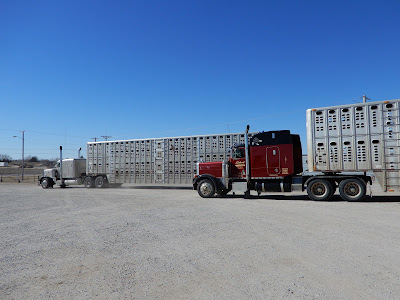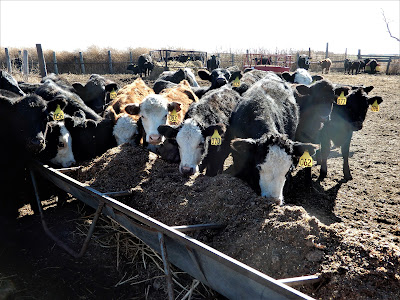I had one of those peripheral vision tests at the eye doctor a week ago. As a firstborn with test anxiety, I absolutely hate those blinking lights and the pressure to click my little signaling button at the correct times.
"Did I miss one?" "Why is there so much time between blinks?" "Am I going BLIND?"
I have horrible eyesight: It's -6 in the right eye and -7.5 in the left - whatever that means. In real life, it means that my glasses are the first thing I put on in the morning and the last thing that hit the bedside table at night.
I had a vision test of another kind last week, too. It was just as difficult. It involved trying to pick out little orange "earrings" on feeder calves while they were moving. I didn't take any photos of the sorting process that day. As Randy says, I was a little busy at the time. But I found a photo I took from the feed truck which demonstrates what a challenge this eye test can be.
Here' a better look at the tag from a different sorting event several years ago.

Last week, we gathered the feeder calves so we could sort the heifers (girls) from the steers.
We've been feeding them silage and hay since we weaned them from their mothers last fall.
Once we had the 95 calves up in the sorting pen, our mission was to sort the heifers with the calfhood vaccination tags from the steers and the unbanded heifers.
Easier said than done. It's not easy for people with good vision to see the orange tag on the right ear. It definitely raises the level of difficulty for someone with poor vision like me!
We retain 25 heifers which were calfhood vaccinated last fall as replacement heifers for our herd. The heifers will have their first babies next January/February 2022. The heifers without the calfhood vaccinations and the steers made a trip to the Pratt Livestock sale barn last week.
To sort, we keep running the calves into smaller corrals. Randy and I were the sorters. Our neighbor, Todd, ran the gate in case one - or more - got past us. Besides the fact that the orange tags are pretty tiny on a 650-pound animal, it seems they further complicate the task by turning their rear ends toward us instead of facing forward. They also have their winter hair, which sometimes makes it hard to see their orange vaccination band on hairy ears, especially at a glance.
Last November, Dr. Bruce Figger came to the County Line to help us work calves that had been born last winter. As heifers came through the chute, Randy would decide whether or not it
was one he would potentially want to add to our herd. If she was in good
body condition and had good confirmation. Dr. Bruce would give her a
calfhood vaccination.
 Dr. Bruce uses a device to "tattoo" the animal to show it had received
the brucellosis vaccination. Then he used green ink to mark the tattoo.
Dr. Bruce uses a device to "tattoo" the animal to show it had received
the brucellosis vaccination. Then he used green ink to mark the tattoo.
The orange "bands" help identify the calves who've been calfhood vaccinated. Most of these heifers become part of our cow-calf herd and will have their first calves in 2022 as 2 year olds.
After sorting, the 25 heifers were sent into a separate lot, and the remainder went back to the pasture until Wednesday morning, when the semi truck arrived to take them to the sale barn.
Selling cattle always puts a smile on the farmer's face.(I was smiling for a different reason. We didn't have to complete this task the previous week - when it was -14F. And I wasn't the one having to back the semi up!)
Though we have two farm-sized cattle trailers, it would take several trips to get all the cattle to the sale barn. So we hired Darrel Harner Trucking to do our hauling to market.
The semi is divided into different compartments, which can hold anywhere from two head to 25 head of cattle. Darrel told us how many calves he wanted at a time to load the semi, and we sent them on their way.
We met Darrel and the cattle at the Pratt Livestock sale barn for the unloading.
With semis and small trailers coming into the sale barn yards, it was like a traffic jam - country style.After they're unloaded, the cattle are put into different lots to await sale day.
Last Thursday, the Pratt sale barn had some 4,200 cattle go through the auction ring. Ours were among them.
The price on feeder calves is down some. But it's still a good feeling to get a paycheck for all the work.
We sold 27 heifers (average weight of 614 pounds each) and 43 steers (average weight 734 pounds each.)
 |
| January 2020 - 2nd calf born in 2020. |
It's an end to a year-long journey, which began with their birth last winter. There were plenty of chapters to the story between then and now ...
... from working calves on our 39th wedding anniversary (note the ear tag number) ...
... to sorting, loading and transporting the calves and their moms to summer pasture ...
... to gathering and bringing them back home again in the fall ....... working them again ... (missed photos of that this year) ...























I love virtually joining you on your big farm work days. What a relief that it was slightly warmer than more recent days. Darrel and his trailer setting off to the markets truely emphasises the flat vastness of Kansas.
ReplyDeleteOur part of Kansas is definitely flat. There are places in the state that have rolling hills - the Flint Hills near Manhattan (where we went to college) and the Gyp Hills near Medicine Lodge.
Delete